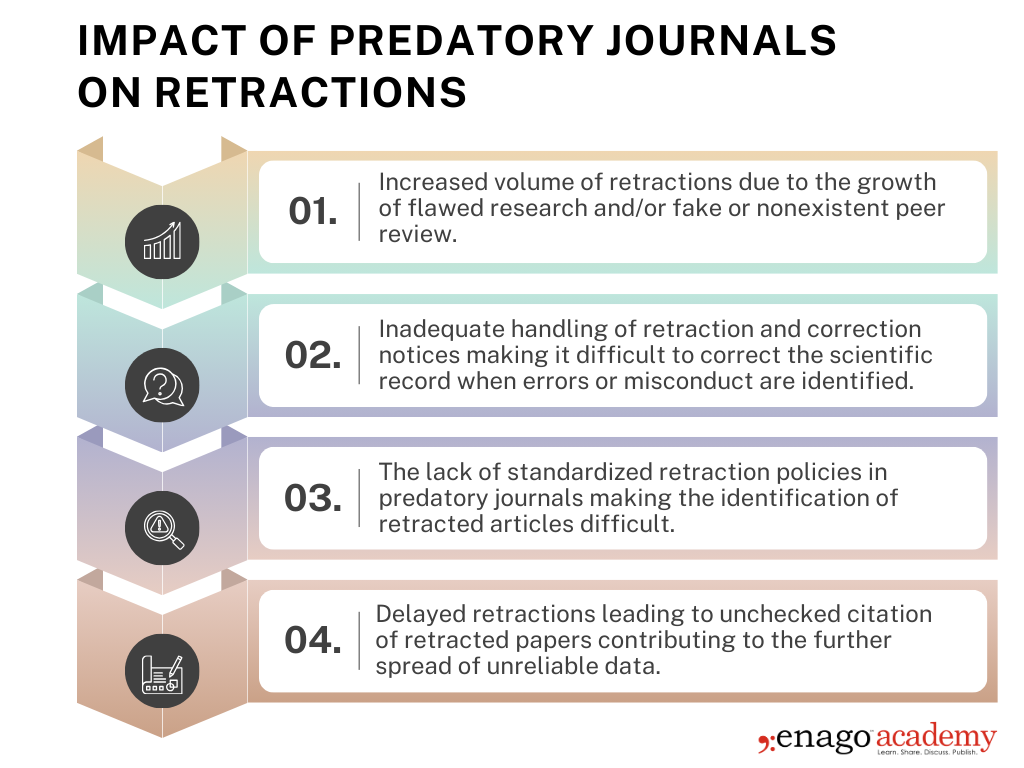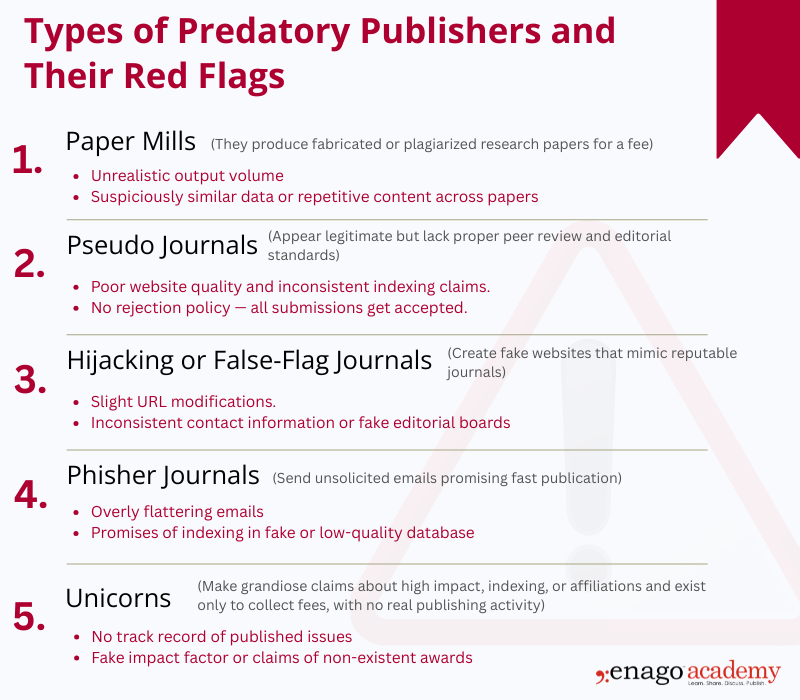Maintaining research integrity and public trust in research has become increasingly challenging due to the surge in retracted studies and the unchecked growth of predatory journals. Research retractions, the formal withdrawal of published studies, have seen a notable increase in recent years. This surge can be attributed to factors such as heightened detection of errors and misconduct, reflecting both improved scrutiny and underlying challenges in research practices. At the same time, it’s rise is also attributed to predatory journals that publishes low-quality or fraudulent studies without proper review.
What are Predatory Journals?
Predatory journals are pseudo journals or deceptive publications that exploit the open-access model by charging authors exorbitant fees without providing legitimate editorial and publishing services like rigorous editorial and peer review. Unlike reputable open-access journals setting strict scholarly standards, these journals prioritize monetary profit over research quality. As a result, articles are often accepted without proper evaluation. Some characteristics of predatory publishers include:
- Accept articles with little or no peer review or quality control quickly
- Lack of defined eligibility and manuscript acceptance criteria/process and APCs
- Publishing low-quality articles and including low-quality and fake papers
- Notifying academics article fees only after papers are accepted
- Aggressive promotion for article submission or serve on editorial boards
- Host fake academics on editorial board
- Copy the name or website designs of high-impact and well-established journals
- Make false claims about their indexation and standard identifiers
- Lack proper contact details
The surge in predatory journals has been discussed as a major agenda item at the ICMJE (Nov 2024) and APAME (Aug 2024) meetings, highlighting growing concerns among top academic publishing bodies.
Growth of Predatory Journals Over the Years and Its Impact on Retractions
Jeffrey Beall — who coined the term “predatory publishers” began tracking them in early 2010 with a list of 20 journals during his research on questionable research practices. By early 2014, this list grew to 700 predatory publishers and articles in such journals surged from 53,000 in 2010 to over 420,000 in 2014. Furthermore, Cabells’ 2022 report revealed the number of predatory journals at over whooping 15,000!
 Data from Retraction Watch database between 2023 to till date accounts 14.6% of the total retractions to predatory publishing practices. As predatory journals do not deal with corrections and retractions timely, they may lead to delayed retractions. Delayed retractions are problematic, as they allow flawed research to influence subsequent studies, potentially leading to a cascade of misinformation, creating a ripple effect that halts scientific progress.
Data from Retraction Watch database between 2023 to till date accounts 14.6% of the total retractions to predatory publishing practices. As predatory journals do not deal with corrections and retractions timely, they may lead to delayed retractions. Delayed retractions are problematic, as they allow flawed research to influence subsequent studies, potentially leading to a cascade of misinformation, creating a ripple effect that halts scientific progress.
How Predatory Journals Handle Correction Requests and Retractions
A study found that among 1,511 standalone predatory journals listed in Beall’s List, only 46 journals had retracted articles, totaling 645 publications as of 2022. These journals were found to have inadequate documentation of retraction policies, poor availability and visibility of retraction documents, and weak information on retraction notices. Here are some ways how these journals respond to corrections and/or retractions.
1. Ignoring or Refusing Retraction Requests
- Many predatory journals simply do not respond to correction or retraction requests, even when serious ethical violations are identified.
- Unlike COPE-member journals, which have clear policies for handling errors, predatory publishers often proper lack retraction guidelines.
2. Charging Fees for Retractions
- Some predatory publishers demand additional fees to retract an article, exploiting researchers financially.
- This unethical practice discourages authors from retracting flawed work, leading to continued misinformation.
3. Silent Retractions (Removing Papers Without Notice)
- Instead of issuing a formal retraction notice, some predatory journals delete the paper from their website without explanation.
- This lack of transparency makes it difficult for other researchers to know whether a study was removed due to ethical concerns.
4. Republishing Retracted Papers Elsewhere
- Some predatory publishers resurface retracted papers in different journals within their network, often with minor edits.
- Since these journals are rarely indexed in major databases, detecting duplicate publications becomes challenging.
5. Misleading or Incomplete Retraction Notices
- If a retraction is issued, predatory journals often fail to provide proper justification, making it unclear whether the paper was retracted for misconduct, errors, or ethical violations.
- Some journals blame the author instead of acknowledging their own failure in peer review and editorial oversight.
Predatory journals lack accountability when handling corrections and retractions, further compromising research integrity. To combat this, researchers should avoid predatory publishers, and institutions must strengthen policies for tracking and flagging unreliable publications.
Avoiding Predatory Journals and Retractions: Best practices for researchers
To prevent retractions and safeguard their work, researchers should take the following steps:
1. Verify Journal Legitimacy
Check if the journal is indexed in trusted databases like Scopus, Web of Science (for impact and legitimacy), DOAJ (Directory of Open Access Journals) (for credible open-access journals), PubMed, MEDLINE (for medical and life sciences research). Additionally, search for past retractions linked to the journal in Retraction Watch Database or PubPeer.
2. Assess the Submission Guidelines and Peer Review Processes
Review the journal’s submission guidelines for transparency in peer review, open access policies, and ethical standards. Verify the editorial board’s credentials by checking their affiliations and prior publications. Ensure the journal follows a robust peer review system (single-blind, double-blind, or open peer review) instead of merely accepting papers for fees.
3. Watch Out Red Flags
Be cautious of journals with unusually fast acceptance times (e.g., acceptance within days or a week) without detailed peer review, excessive publication fees without clear justification or waivers for low-income countries, generic or vague peer review descriptions that do not specify reviewer criteria or decision timelines, and aggressive solicitation emails with promises of quick publication.
4. Use Blacklists and Whitelists
Refer to established lists of predatory journals, such as Beall’s List, and consult academic institutions for recommendations. Use trusted whitelists such as DOAJ, COPE-member journals, and university-recommended journals and look up publisher reputation using Think. Check. Submit. to validate its legitimacy.
5. Understand Predatory Journals and Their Impact
Stay updated on predatory journal tactics and understand the different types of predatory journals and their warning signs.
 Safeguarding research integrity requires a multi-layered approach that combines stringent regulations, proactive oversight, and technological advancements to combat predatory publishing. Researchers must remain vigilant in selecting credible journals, while institutions and policymakers should enforce stricter guidelines and promote transparency in scholarly publishing. Additionally, AI-powered detection systems and global collaboration can play a crucial role in identifying and eliminating unethical publishing practices. By fostering a culture of ethical research, accountability, and awareness, the academic community can uphold the credibility of scientific literature and ensure that research contributes meaningfully to global knowledge.
Safeguarding research integrity requires a multi-layered approach that combines stringent regulations, proactive oversight, and technological advancements to combat predatory publishing. Researchers must remain vigilant in selecting credible journals, while institutions and policymakers should enforce stricter guidelines and promote transparency in scholarly publishing. Additionally, AI-powered detection systems and global collaboration can play a crucial role in identifying and eliminating unethical publishing practices. By fostering a culture of ethical research, accountability, and awareness, the academic community can uphold the credibility of scientific literature and ensure that research contributes meaningfully to global knowledge.









